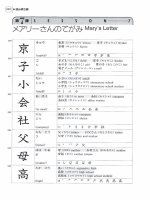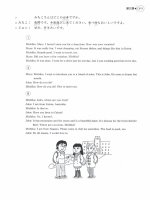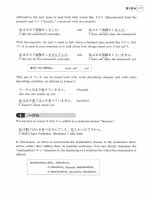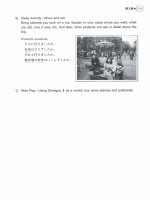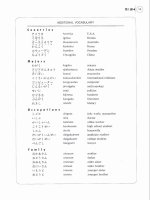genki 1 an integrated course in elementary japanese1 phần 6 docx
Bạn đang xem bản rút gọn của tài liệu. Xem và tải ngay bản đầy đủ của tài liệu tại đây (3.82 MB, 31 trang )
A.
Sue
is
going
to
the
following
places
to
do
the
things
below.
Make
sentences
like
the
example.
@
Exa
-
75'.,i=
3
(Kabuki)
-%
Fb
&
A
-3
kI;t;g@i:hll:=3
2RC=E
Sri
Z
k
B.
For
what
purpose
would
you
go
to
the
folIowing
places?
Pair
Work-Ask
your
partner
the
following
questions.
ExampIe:
A
:
~Ql%~G=~~hh~#TA~~$~i5~,
0
Q
VY
2,Ll:'L
2.
~~~~tt
X~~AL
-,
a
~p-5~~
o
UX.
fr~cr~.
(nationality)
A.
Answer
the
following
questions.
6.
Class
Activity-Show
a
picture
of
your
family
to
the
class
and
describe
it.
1.
Someone
I
Else's
Family
1
Mother
11.
Own
Family
A:
Formal
Situation
B:
Informal
Situation
I
Father
&XSL,
t:
-i
I
I
X
.
L
->
-,
c
i
&XSL
I
Older
sister
!
S@(;fi4k
r22
@
h
rl
i3%3iL
I
fl
f.
I
I
I
I
k;X,FtShi
I;II
Older
brother
Younger
brother
Younger
sister
1
Child
I
1
%?%A
1
?J
%a3
.
I
Grandmother
*Depending
on
each
person, several
words
are
used
for
spouses,
e.g+,
for
husband,
TSLQ,
i%ah,andforwife,3rB,
747,
ha44tL,
andsoon.
>'?
!
:I+
13
GE3h
!=
xir
$$A
,
*SX,
,2+r
1
A
:B1~~~0fjX?~ldh~Si~~
Hm0ldi~yowfaN2ey,Mr.
Tanaka?
I
t:
Th,
Y
9
$&?rr
X.
h
I:
f;r+t:
%
,
a
,.;if
%t2&2,4,
B
:[formal]
Xi25+&TTo
%
I
Cbi,?4L\
My
father
.is
50
years
old
Cinformall
i%
X
3
A
ii5+%
TTo
t:
i
;.
I+'-$LI
Husband
1
r"&
x
I
Where
does
your
older
brother
live,
Mr.
Tanaka?
&A/*
L*LL
%<f
@PI,"$
n,'i.:5
3i
$B
x
t
.i.
Wife
+
[I
Note
that
you
can
use
;k;
i-,'
X,
5
h
and
;f;%
2
tt
when
you
talk
to
your
older
brothers
.h
r
and
sisters,
The
younger
brothers
and
sisters
are
called
by
their
names.
'(See
below.)
*(See
below.)
j%C~\3,&
LnCA
g
<
%tS&i,L
Younger
brother:
6
X,
5
A,
I.
Hi,
Big
Brother.
.
-
Older
brother:
FJ
?
ik
5
5
,
What
is it,
Taro?
Q!:
Grandfather
1
'
j
p-<+7
-
Barbecue
@
At
school.
@
Robert
is
cooking
at
the
barbecue.
Michiko:
Takahi,
would
you
like
to
have
a
barbecue
party
tomorrow?
Takeshi:
That's
nice.
Who
will
come?
Michiko:
Sue
and
Robert
will
come.
I
think
Mary
will
come,
too.
Takeshi:
How
about
Ken?
Michiko:
Ken
said
he
had
a
part-time
job.
Takeshi:
Too
bad.
Shall
I
bring
something?
Michiko:
I
think
nothing
is
needed.
Michiko:
You
are
good
(at
cooking).
Do
you
like
cooking,
Robert?
Robert:
Yes, I
often
cook
at
home.
Michiko:
Shall
I
help
you
with
something?
Robert:
Well
then,
cut
the
tomatoes,
please.
* *
Robert:
Shall
we
start?
Michiko:
Don't
drink
yet.
Mary
said
that
she
would
come.
Man:
I'm
sorry
for
being
late.
Everyone:
Well
then
. .
.
Cheers!
the
day
after
tomorrow
rain
office
worker
camera
karaoke
air
this
morning
this
month
job;
work;
occupation
college
student
disco
weather
forecast
place
tomato
summer
something
party
barbecue
chopsticks
winter
homestay;
living
with
a
local
family
every
week
next
month
skillful;
good
at
.
.
.
(w&~)
clumsy;
poor
at
. .
.
(-fir)
famous
it
rains
to
wash
to
say
.
*
Words
that
appear
in
the
dialogue
to
need
(-dP)
to
be
late
(for
.
.
.
(-I.=)
to
think
to
cut
to
make
to
take
(something)
t'
6
U
6
R
b
to
stare
(at
.
.
.
)
%bfi6
to
begin
to
drive
(-
T?
to
do
laundry
to
clean
Adverbs
and
Other
Expressiaas
?)?A
uh-uh;
no
5A-J
uh-huh;
yes
*
i3hA,12P~~
&fT
Cheers!
(a
toast)
*
y&ibA,
(Tph)
B%(TTh)
That's
too
bad.
*
3
f5
+
negative
not
.
.
.
yet
*
k&QT
all
(of
the
people) together
Grammar
f3h,
I%5
In
this
and
the
next
lesson,
we
will
learn
a
new paradigm
of
conjugation,
which
we
wiIl
1
call
"short
forms.
"
Before
we
start
worrying
about
their
meaning
and
how
they
are
used,
let
us
first
see
what
they
look
like.
It
should
be
obvious
why
they
are
called
short
forms.
We
will
list
the
already
familiar
"long
forms"
to
the
right
in
the
table
below.
bsent
tense,
affirmative
1
verbs:
1
L\-adjectives:
&-adjectives:
noun
+
Tg:
,
Present tense,
negative
verbs:
td-adjectives:
noun
+
Tq:
short
forms
short
forms
long
forms
long
forms
The
following rules
summarize
how
short
forms
are
constructed.
pp
-
I
Verbs
and
I,\-adjectives in
the
affirmative
(a
above)
3
same
as
their
dictionary
forms
&-adjectives and
noun
+
Tq
in
the
affirmative
(b
above)
I
+
replace
77
with
E
L\-
and
a-adjectives
and
noun
+
r$
in
the
negative
(d
above)
1
+
rrpace&~dtihiwiihfdli
I
'Various
names
have
been
given
to
this
paradigm.
They
include
"pIain
forms,"
"informal
forms,"
and
"direct
style."
Long
forms,
on
the
other
hand,
are
often
called
"polite
forms,"
"formal
foms,"
and
"distaI
style."
As
noted
in
Lesson
5,
the
adjective
L>L\
is
irregular.
Its
negative short
form
is
k
<
3~~.
Verbs
in
the
negative
need
to
be
analyzed
in
more
detail,
because
7%-,
u-,
and
irregular
verbs
conjugate
differently.
Negative
short
forms
of
verbs
(c
above)
ru-verbs:
Take
the
final
5
off
and
add
at\.
5
3
&aLl
k
It
U-verbs:
Take
the
final
-u
off
and
add
-anai.
=<
ii'
+
s;h*aLI
?i'
*a
7<
+
IT%&L1
3<
33
m
s
%&&L\
Rig:
5%
<
a&
+
%hvLLI
G3
*
+
ejr-,aL\
*
VJ~
d
j
lwd3zL1
d
E&S1
L
+
EaaL\
L
9'
I&?JL?
h'
%&
&
+
FbaLI
irregular
verbs:
gzj
+
LZXLI
+
za~i
exception:
&.a
+
Wrn
With verbs in
the
negative,
the
following
three
points are
worth
noting.
(1)
The
negative
short
forms
of
verbs
that
end
with
the
hiragalza
?J
are
b
td:
I
\
instead
2
of
$Q~:L\,
f2)
The
vowel
changes
with the irregular verb
<
4.
f3)
The
verb
$J
B
in
the
negative
is
l\.
We
now
turn
to
discussion
of
how
we
utilize
short
forms.
In
this
lesson,
we
will
learn
to
use
the
short
forms
in
the
following
four
contexts:
*In
represented,
or
quoted,
speech
("I
think
. . .
,"
"She
said
. .
.")
aIn
casual
conversations,
as
signs
of
intimacy
In making negative requests
("Please
don't
.
.
.")
(See
3
on
p.
157.)
A.
2This
suggests
that
the
bases
of
verbs
like
R
3
and
%
i
actually end
with
the
consonant
w.
This
conso-
nant
remains
dormant
when
the
base
is
[illowed
by
the
vowel
i,
thus
we
have
3
5t,
where
w
is
d'
lacking,
but
it
surfaces
with
the
vowel
a
following,
3T
A
b
This
mystery
consonant
also
explains
why
*-
the
te-form
of
such
a
verb
has
the
small
9,
just
like
verbs
whose
bases
obviously
end
with
a
consonant,
such
as
Z
5
and
99.
In
expressing ideas like
"I
like doing
.
. ."
or
"I
am
good
at
doing
.
. ."
(See
4
below.)
Quotations
To
quote
a
person's utterances
or
thoughts, you
use
a clause ending with
a
predicate in the short form,
plus
Z
S
7
T
L
12
L
f:
(They
said
". .
."I,
kf
,E!
LI
3
T
((I
think
ti,
that
.
.
;
),
and
so
forth.
L
is
a
quotation particle, which
does the
job
of
both the English
word
"that" in indirect quotation and
of
quotation marks
(" ")
in
direct quotation.
a
0
Z-$,Lli,
&
L7?%s6xh6
Z%~TL>~
Lk',
L
lix.
\I
Sue
said
that
there
would
be
an
exam
tomorrow.
($LIrit)
?:I?
L
3
hid%
7
]I
-
s
LhWI
ez,~~\a
-k4
h?:L
i
i;
<
1
think
Takeshi
likes
Mary.
Casual
conversations
Two
people
who
are
close
friends
or
family
members
speak
with
short
forms
at
the
end
of
sentences, using
them
as
a
sign
of
intimacy.
The
use of
long
forms,
in
contrast, tends
to
imply
the
speaker's
intention to
"keep
a
proper distance" from
the
listener.
Short
forms,
then,
are
like talking
on
a
first
name
basis, while
long
forms
are
like
using
"Mr."
and
"Ms."
It
may
not be
easy
to
decide
when
it
is
appropriate
to switch to
short
forms.
First of alI,
Japanese
speakers
are
often
very
conscious
of
seniority.
A
year's
difference
in
age
may
in
many
cases
totally
preclude the
possibility
of
establishing
a
truly "equal" relationship.
3Note
that
the
present
tense
in
Sue's
original
utterance
is
preserved
in
Mary's
report.
4To
say
that
you
&'t
fhi~k
something
is
the
case,
it
is
more
common
in
Japanese
to
say
it
like-$bl
2,E
b1Z
(I
think
that
something
is
not
the
case)
than
l:
,Fi
1,125
+.?A
(I
don't
tksak).
Therefore:
bt
+3
h
(%L~)$~~)-SAI~)F;~?LPL;~P@~~;JP~~~~,B~~ST~
ft;&'t
think
Mary
likes
~akeshf
(=l
think
Iw"a"ry
doesn't
like
Takahi)
Second,
license
to
use
short
forms
is
not
mutual;
senior
partners
may
feel perfectly
justified
in
using
short
forms while
expecting
their
junior
partners
to
continue
addressing
them
with
long
foms.
Thus
if
somebody
who
is
older,
say,
your
Japanese
language
professor,
talks
to
you
using
short
forms,
they
would
be
greatly
surprised
if
you
should
return
the
favor.
Here
are
a
few
observations on the
grammar
of
short
forms
as
they
are
used
in
casual
conversations.
.In
the
casual
conversational
use
of
short
forms,
question
sentences
do not
end
with
the
question
particle
but
with
rising
intonation
alone.
The
I?
ending
of
3-adjectives
and
noun
+
CT
constructions
(b
in
the
previous
sec-
tion)
is
usually
dropped.
In
casual
conversations,
Cd
\
and
2
are
often
replaced
by
the
less
formal
.j
and
-i
itL.
To
request
that
someone
refrain
from
doing
something,
one
can
use
a
negative
verbal
short
form
plus
t
{
fF
3
I
2
z
-c*F&$$&(,
QLlT
<
fZ3
Ll,,
LPLL
Z
PEeme
don't
take
pictures
here.
negative
short
form
+
T<
Tz"eL\
Please
dm't
.
. .
Short
forms
are
used
in
constructions where
verhs
and
adjectives
are
to
be
treated
as
nouns.
Thus
8
t2 $s"3$
3
TTf
3
b
l-iI"
T
can,
besides
describing
your
preference
for
ML
*
items
denoted
by
nouns,
such
as
$3,
also
describe
your
preference
for
activities,
such
as
h
l
swimming,
drinking
coffee,
and
studying
Japanese.
Add
to
a
verbal
short
form
to
express
the
idea
of
"doing
x."
(5%EA)3E2@%-P4
@h45
bbW-P,
hi'i
r
+-?<
-
I
don't
like
clea~z.czrag
my
room.
"To
be
good/bad at
doing
something"
is
9~~13 I-3
(is
good
at.
.
.
and
-&zT+T?
5
Uii
f
-
f:
(is
bad
at
.
).
UY<
3
Li3++3Z!24+6
CTJ&'L+TT~
Iri
'I
7(
-
L'ii
-f
Robert
is
good
at
cooking
meals.
k
Cj
L
3
kla~z%%-if~1'T4-I"To
1
.
(2%
-
r:
Takeshi
is
not
a
good
speaker
of
English.
person
(a
activity
(verb)
Gl)~
like
doing
.
.
.
doesn't
like
doing .
. .
is
good
at
doing
.
.
.
is
pour
at
doing
. .
.
It
is
a
common
mistake
to
use
the
te-form
of
a verb
in
such contexts, misled
by
the
association between
S
L~
b
and
the
verb
in
the
-ing
form
in
English.
Consider what
n
f-
b
$
tt
l3iT,%
tcfi
3
3
t
f=
means.
This
sentence
of
course
is
about
Z*f1h
8,>
Robert and
describes
what
he
did.
It
is
likely
to
be
uttered
when
the
topic
of
Robert
has
already
been
breached. Grammatically
speaking,
(I)
the
noun
ol{-
I-
stands
as
the
subject
in relation
to
the
verb
47
(
(he
was
the
person
who
performed
the going), and
(2)
the
noun
is,
per
the
function of the particle
id,
presented
as
the
topic
of
the sentence
(us
for
Robert,
he
went
to
Okinawa).
What
if
we
both
know
that
somebody
went
to
Okinawa recently,
and
I
know
that
it
was
Robert,
but
you
don't.
I
will say:
ROBERT
went
to
Okinawa.
'To
describe
one's
skills
or
Iack
thereof,
we
also
often
use
a
different
set
of
expressions,
namely,
h2Z
{
LxTT
(is
comfortable
with
. . .
1
and
71rzl:75'.ilf
P
(is
uncornfortabIe
with
.
. .
1.
4
*
%T
{
*To
I
am
good
atlcmnfortable
with
speaking
Japanese.
hf:L
,
5,
z
,A%
This
sentence
means
that
Robert
went
to
Okinawa,
which
in
English
would
be
uttered
with
an
extra
emphasis
on
the
name
Robert.
His
identity
is
the
new
piece
of
information
provided
by
this
sentence.
It
is
one
of
the
functions
of
the
particle
15."
to
(1)
present
the
subject
of
a
sentence
in
a
way
such
that
(2)
the
noun
will
"fill
in
the
blank
on
the
information
sheet.
"
The
"blank
on
the
information
sheet"
is
a
question
word
like
fzh
and
FJ.
The
above
Q
[Z
sentence
will
fill
in
the
blank
left
out
by:
t?i#%754iPR
$37
3
2
L
fz
$',
f;_i%$,
Who
went
to
Okinawa?
Compare:
X
-
U
$+%
t
tfi
3
3
L
fz
dao
63Qh
I\
As we
learned
in
Lesson
2,
a
question
word
that
is
the
subject
of
a
sentence
is
never
followed
by
the
particle
lat,
but
always
by
the
particle
h2.
As
we
have
seen,
a
noun
that
will provide
the
answer
to
such
a
question
is
also
followed
by
the particle
h'.
Z*nY7;rh4S%
LSL\T*T~~)>,,
Whkh
class
is
(fhe
most)
interesti~g?
S*~O??X&';~;&
L&L\~**o
i:
IX/L
z
Japanese
class
is.
(2
~',7-3~-C+)iF;';fih~&d~~k
2hht3' C~\a
-$-hh,
Who
wears
glasses
fin
this
class)?
&T%%t~~&&~#a
2
;t)*dfCC
L\
3
To
r2t
Lf:+&.ttt>
Professor
Yamashi
fa
does.
The
word
for
"something"
is
m;b-,
and
the
word
for
"anything"
in
negative
sentences
is
hl:
H&*
tlrz
"Some"
and
*anyM
in:
positive
statements
$iIhx
aE
something
questions
@fix
sl;:
a~ythiw?
negative
statements
@l%
+
negative
nof
.
. .
anythiw
alL
These
two
words
are
used
in
places where
the
particles
13,
75<,
and
2
are
expected.
In
these
contexts,
they
are
used
on
their
own,
without
the
help
of
particles.
We
will
learn
in
Lesson
10
what
to
do
in
cases
where
particles
other
than
these
are
expected.
%&2N$*87
x
3
3
L
fzo
2
k
I
The
cat
has
brought
something.
4%
tJ-Rba&<3
t
7LZ?Po
.a:
Biz
f;
Did
the
cat
eat
anyfhing?
L\L\&.
%13m%+t^;:3*hTL.fto
h'
all
f:
No,
the
cat
did
nof
eat
azythizg.
-Fa
b
Most
irregular
verbs
are
compounds
of
nouns
and
the
verb
T
8.
If
you
have
learned
an
irregular
verb,
therefore,
you
have
also
learned
a
noun.
verbs
nouns
%%3-&
-A323
+"Sx-3
ex.
El&$o)~i2%L~lT%
(:
IZA.
z
-A
*s
*a
to
study
study
Japanese
language
study
is
fun.
NBT&
9k.j
s
HE!
9di
9
ex.
o2f-
E
P
tLOl~l2fib~
Lb3TTo
d
D
to
cook
cookilzg
Robert's
cooking
is
good.
Some
of
these
nouns
can
be
used
as
the
"object"
of
the
verb
9.3.
$L
kiH$zaB%%L3
Lk,,
bPL
tLfX.z-
xAs~7-
I
studied
Jopanesa
4
Compare:
$h
i2EI&s%BBL$.
tko
bf:L
c
IZAUF
4"3~3
TLt3LSA6&~BaBR%
tz
LT<,
?
P
Sic-
Tukeshi
cleaned
his
room.
Compare:
?'
t?
t
3
k
t&3E
f:RR
L
t
L
t<,
P
+5L
/-\
r
:
Short
Forms
i~/
A.
Change
the
affirmatives
into
negatives.
@
Example:
h'
(
$lh'
?
L
B.
Change
the
affirmatives
into
negatives.
@
@
Informal
Speech
A.
Answer
the
following
questions
in
informal
speech,
first
in
the
affirmative,
then
in
the
negative.
@
&
Example:
Q
:
.k
<
,@.
2
&*
8
?
%d.'.i
r:
A
:
?A,
* Go/?
?A,
&GQb~o
t:
f<
B.
Answer
the
following questions
in
informal
speech,
first
in
the
affirmative,
then
in
the
negative.
@
Example:
Q
:
3
%
?
ish-
3
A
:
5
A,
Z%,o/?
3
A,
ZF~J+%'L~~
If&
5
If&
z
A.
Make
a
guess about
Mary,
using
tBLlLf.
$35
Example:
good
at
Japanese
1.
often
cooks
2.
drives
a
car
3.
doesn't
smoke
4.
listens
to
a
Japanese
language
tape
every
day
5.
doesn't
go
home
late
at
night
6.
doesn't
drink
alcohol
much
7.
often
goes
to
see
movies
8.
not
married
9.
likes Takeshi
10.
busy
11.
a
good
student
12.
not
tall
13.
not
scary
14.
not
quiet
15.
not
a
freshman
B.
Make
a
guess about
the
person
or
place
below
and
answer
the
following
questions.
Picture
A
Picture
B
C.
Make
a
guess
about
the
following
things,
using
&EL\%$.
8%
I.
the
weather
tomorrow
2.
the
next
test
3.
what
your
classmates
will
do
tomorrow
A.
Report
what
the
following people
said,
using
tZ=ZL\t
Lf;.
@
Li
Example:
%7'~-/~flld8T&~~~T~o
:,&If7
I
.fi)'
+
Q
:
%7"1 3htJBZZ-;,ril~\3
~t.6~~
EX.
i>
A
:
+aCd*rt
LL\Z~~-CL\~
LLI*
:&It-?
\
+7i:
I
I
B.
Pair
Work-Ask
your
partner
the
following
questions.
Take
notes
and
report
to
the
class
later, using
&FTTLI%
bt;.
What
would
you
say
when
you
want
someone
. . .
Example:
not
to
look
at
your
photo
+
%
?
??
3
{
f?
3
L
io
r,
I.
not
to
speak
English
3.
not
to
come
to
your
house
5.
not
to
smoke
7.
not
to
forget
2.
not
to
calI
you
4.
not
to
go
6.
not
to
sleep
in
class
8.
not to
stare
at
you
9.
not
to
start
the
class
yet
10.
not
to
be
late
11.
not
to
erase
the
blackboard
yet
(2
<
I%A)
A.
Tell
what
Mary
is
good/poor
at,
using
L~
lP7d
T
or
TqTt.
.\
t
Example:
tennis
(good)
+,
%~'J $~IAY=X~:~_~~+T-$,
ci+
7
swimming
(poor)
+
%
r
'1
-3
hl;t*(aa7Sf7;+T-j-,
2
-
7:
1.
French
(good)
2.
video
games
(poor)
3.
cooking
(good)
4.
making
sushi
(poor)
5.
speaking
Japanese
(good)
6.
taking
pictures
(good)
7.
driving
a
car
(good)
8.
eating
with
chopsticks
(good)
9.
writing
love
letters
(good)
(77b9-)
B.
Pair
Work-Ask
if
your
partner
likes to
do
the
following
activities.
Example:
studying
1.
eating
2.
sleeping
3.
singing
4.
doing
shopping
5.
playing
sports
6.
studying
Japanese
7.
doing
cleaning
8.
doing
laundry
9.
cooking
10.
taking
a
bath
11.
driving
a
car
12.
washing
a
car
*
If
you
neither
like
it
nor
dislike
it,
you
can
use
$f
3
T
&
3
h
i\T
%
W
1
I
*A.
A.
Use
the
table
below
and
answer
the
questions.
@
Example:
Q
:
ffd'L2~'d
XAT?6xo
UX.
B.
Pair
Work-Use
the
table
above
and
ask
your
partner
questions
with
Ehtii.
A.
You
went
to
a
party
but
did
nothing
there.
Make
sentences
using
the
cues.
W
doesn't
like
cats
likes
dogs
likes
cats
doesn't
like
cats
Example:
.'
f -7
4
-
b=e
3
3
L
1z
6'.
(eat)
i
went
to
Okinawa
last
weekend
had
a
date
last
weekend
went
to
Tokyo
last
weekend
had
a
date
last
weekend
1.
~f-74
-I=?f3
3
Lf.:hS,
(drink)
I
r
2.
fi
7;573-Y&'&
9
3
L
Ah.",
(sing)
cooks
often
does
not
cook
cooks
sometimes
always
eats
at
cafeteria
3-
7-bW&'&
9
3
tf:&.'.
(watch)
is
good
at
cooking
is
good
at
skiing
is
good
at
singing
is
good
at
swimming
Robert
Mary
Sue
Takeshi
4.
fJ
%
7'
2%-
TL\~
L-fz7fii',
(take)
P
British
American
Korean
Japanese
5.
@A
3
/t,tz+~\3
L?Z&~,
(talk)
A
6.
2f-74
i=@3
3
tfzh2,
(do)
B.
Answer
the
following
questions.
Example:
Q
:
3
'j
@R
ZE3
X/
3
3
L
7i
15.,
If
X.
'61:
7(
A
:
13~1,
Z/pY.;r?-f
(spaghetti)
&@3
3
Lk,
7
<
A.
Interview
one of
your
dassmates
about
any
future
plans
and
report
to
the
class.
6.
Pair Work/Group
Work-You
are
planning
a
party.
Decide
on
the
following
points
and fill
in
the
chart.
C.
Class
Activity-find
someone
who
.
.
.
I.
likes
to
study
Japanese
2.
hates
to
do
cleaning
3.
Iikes
to sing
4.
is
poor
at
driving
5.
whose
mother
is
good
at
cooking
D.
Pair
Work-A
and
B
are
making
plans
for
a
one-day
trip
with
two
other
friends
C
and
D.
A
knows
C's
schedule
and
B
knows
D's
schedule.
Play
the roles
of
A
and
B.
Discuss
your
own
and
your
friend's schedules
using
&E=ZL\Sbfz,
L\
and
find
out
which
days
all
four
of
you
are
available.
Example:
A
:
~*ElC~P~
TTha,
Uni6
<
L:T
B
:
L\c\;Z,
EL\$@~c?T~
3
-f,
12,
Z+3
TT6*0
b-
LO
bl
Unili%l:&
A
:
$AGJ.,
FJt
L3*k,
Tk,C
~X,h'&92W,I=fi{
ZZ9-C
bf:L
24:
1'
k
k
k
~4
Lk,
Student
A
A's
schedule
1
C
told
A
that he
would
. .
.
18th:
go
to
see
a
movie
24th:
meet
friends
1
26th:
go
to
Osaka
to
have
fun
21
22
quiz
party
28
29
part-time
job
16
23
17
24
I8
25
19
26
20
study
27
Student
B
1
B's
schedule
D
told
B
that
she
would
.
.
.
19th:
do
a
part-time
job
27th:
go
to
eat
Japanese
cuisine
28th:
go
to
Kyoto
to
see
temples
16
shopping
23
17
work
24
18
25
19
26
20
27
21
28
22
tennis
29
work
b\,3<*-
L
Kabuki
&
-
n~g
a
Dialogue
@
a
Mary
and
Takeshi
are
talking.
@
During
intermission
at
a
Kabuki
theater.
@
At
a
concession
stand.

